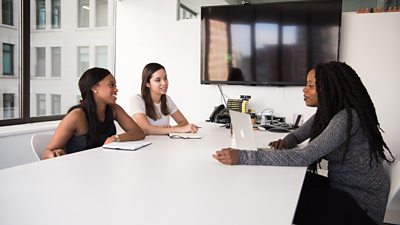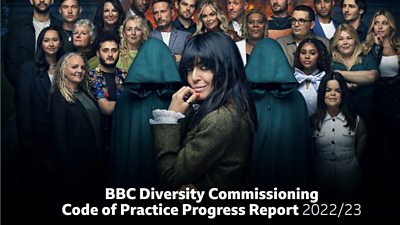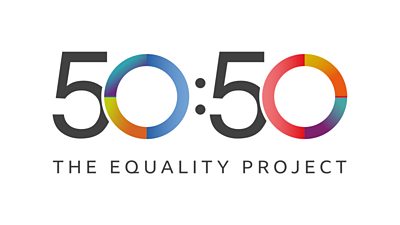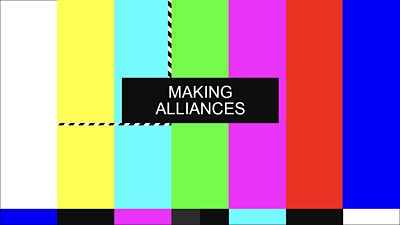Television pre-production

Pre-production is all about planning and preparation, a prime opportunity to ensure diverse representation and an inclusive environment for those on your production.
Focussing on this at the start, setting out your intentions clearly and transparently, will help you to frame the rest of your production process in an inclusive way.
Engaging with commissioners and the ±«Óãtv Creative Diversity team as early as possible will help ensure you create an inclusive production team and achieve authentic portrayal.
Check out how you can achieve this effectively and simply across the key stages of pre-production both on and off-screen:
Pre-production meetings provide opportunities to set expectations and to communicate what your diversity plans and commitments are to everyone on the team.
Use them to discuss and agree the outcomes your diverse production team is seeking.
Establish ground rules for appropriate behaviours and create a culture that ensures everyone is included in the decision-making process, irrespective of grade or experience level.
Confirm that will be supported on your production.
The (TAP) has been created by the ±«Óãtv, Channel 4, Britbox International, Disney+ UK, ITV, Paramount, Prime Video, Sky and UKTV, with support from the Creative Diversity Network (CDN) and PACT.
It aims to substantively and permanently improve access for deaf, disabled and/or neurodivergent talent across the TV industry.
These are some things that you can do to meet diversity commitments in your pre-production meetings:
1. To ensure the full and equal inclusion of deaf, disabled and/or neurodivergent talent, both behind and in front of the camera, organisations should adopt these standards: the 5 A's
- Anticipate
Expect to work and continue to work with disabled people on a regular basis. Keep ahead of the game and ensure your structures, processes and environments are and remain inclusive. Engender confidence among disabled talent by actively communicating and demonstrating how you are inclusive. Always seek expert advice and stay up to date with best practice.
- Ask
Sensitively and as standard practice, regularly approach every team member, whether they have a condition or impairment that is immediately apparent or not, to invite them to discuss any adjustment needs or access requirements they have in order to fulfil their role. Focus on access and adjustments, not conditions or impairments and let disabled people own those conversations.
- Assess
Value self-reflection. Be clear and transparent about how accessible you are, ensuring that disabled talent can easily find out about your access provision and support without having to ask. Agree to consistently sense-check that you have created a working culture where everyone feels open, confident and safe to communicate their access needs, bringing in specialist expertise when needed. Regularly evaluate and improve your inclusion policies and practices.
- Adjust
Deliver what is needed. Consistently, and well ahead of time, put in place any and every reasonable adjustment to ensure the full inclusion as well as the physical and emotional wellbeing of disabled talent. Do this before, during and after their involvement with you. Do so with the support of relevant experts and ensure you have sufficient funding in place.
- Advocate
Set high standards for everyone. Celebrate what disabled talent bring and actively champion them. Do not tolerate any inappropriate behaviour, language or attitudes and think long-term to consistently support the progression of disabled talent into senior roles.
2. Outline expectations for inclusive behaviours, practices and language:
- Use appropriate language and be aware of the impact of micro-aggressions (statements, actions, or incidents regarded as instances of indirect, subtle, or unintentional discrimination against members of a marginalized group) and take steps to limit or avoid them.
- Ask colleagues how they identify so you can use appropriate language
- Ask meeting attendees if there are any adjustment needs
- Share agendas prior to meetings
- Activate subtitling for Zoom/Online meetings
- Invite all attendees to contribute and share views and opinions
- Ensure a culture where junior colleagues are supported and encouraged to grow
3. Ensure everyone is familiar with the diversity requirements of the broadcaster. The ±«Óãtv has made commitments to diverse and inclusive production.
4. Create an expectation that recruitment practices will be inclusive
- It is expected that your recruitment processes will comply with relevant employment law and the Equality Act 2010
- Check your recruitment processes are open and equitable from the outset
- Actively welcome applications from diverse talent
- Consider using inclusive language in addition to 'equality statements' to demonstrate your inclusive culture.
- Consider using a to check your job adverts are inclusive
- Check your website is fully accessible
- Hire team members based on skills and capability.
- Consider the accessibility needs for neurodivergent, deaf, blind and disabled people
- Identify and allocate production crew who can support emerging talent once on your production
- Advertise in a variety of places and platforms that develop diverse talent
- Actively engage with diverse networks and groups who are developing and cultivating under-represented talent. Inviting them to review your recruitment processes may identify barriers that you may not be aware of
- The concept of "nothing about us without us" might be helpful to remember. This means seeking advice from people with lived experience to check that your ambitions for inclusive recruitment are relevant and achievable
5. Familiarise the team with reporting and the need to engage with or complete your ±«Óãtv Diamond forms at the start of the production.
6. Check that production documents and resources are accessible.
- Make it clear that documents can be available in alternative formats such as large print, braille or printed coloured documents
- Make resource materials available and easy to access
- Check whether adjustment needs are being met
7. Provide career opportunities.
- Ensure that career development opportunities and work experience programmes are made open and inclusive
- Ensure work experience placements receive expenses and that interns are paid
- When offering work experience, check there is a formalised training dimension with objectives, practical skills acquisition and set achievable goals
- Provide regular feedback without waiting to be asked
- Identify opportunities at all levels: entry, shadowing and mid to senior level using initiatives such as
- Mentor and sponsor under-represented groups and deploy reverse mentoring to enable senior team members to learn from emerging talent
- Provide safe and confidential spaces for under-represented talent to discuss their experience of working on your production
8. Support positive action.
Positive action can be used to develop people from under-represented or disadvantaged groups to gain skills which will enable them to better compete with others and help widen the talent pool.
Positive action is permitted by law where an organization has evidence that people from particular groups are under-represented in the workforce.
People who are developing their skills through positive action should not be made to feel different from others.
Useful links for implementing positive action:
If you are working on a scripted show consider the following:
1. A diverse range of voices can help your script become more authentic and accurate.
2. Production teams should be encouraged to think widely and seek stories, viewpoints and lived experiences from diverse and inclusive perspectives.
- Contributors should include people with varied lived experiences, social backgrounds, age, gender, disability, religious beliefs and sexual orientation
- Consider using multiple research tools, desktop research, testimonials etc
- Invite third party experts to read your scripts, giving them plenty of time to offer their feedback. This will allow you to make any changes in good time.
3. Script changes and notes should be offered in alternative formats to meet diverse needs.
4. A "nothing about us without us" approach means involving those who would identify with the themes in your script in the script review process.
Production budgets can often be tight, but there are ways to ensure it supports your diversity goals.
Talk to the ±«Óãtv Creative Diversity Team to ensure you are aware of all the funding opportunities that can support you in engaging with diverse talent.
Additional steps include:
1. Check with the commissioner about funds available such as the Diverse Talent Development Fund and placements.
2. We will support our suppliers as much as we can to ensure equity for all talent working on or off air/screen. Do ask for support should talent have needs that require our support.
3. Work with Business Affairs to agree lines in the budget for reasonable adjustment needs and check on adjustments for workers with disabilities or health conditions.
4. Be aware of the government's funding that is available for people with physical or mental health conditions and disabilities.
5. Review budgets for potential cost savings that can be made to free funds.
It’s natural to hire talent that we’ve worked with before. At the pre-production stage we are able to diversify our key crew to be more reflective of the whole of UK society.
Things to consider:
1. The ±«Óãtv has set diversity requirements for key production roles, ensure you're familiar with the criteria
2. Expand your networks and contacts to hire diverse talent in senior roles
3. Throughout the year create opportunities to engage with all talent, building a diverse pool you can recruit from quickly.
4. Engage with organisations across the UK who have access to diverse TV talent, broadening your base.
5. Consider whether the diversity of your senior production team is in line with our £100m investment criteria.
6. Consider opportunities to progress diverse talent in both junior and senior roles
7. Consider appointing at least one person in a senior role that you’ve never worked with before
The Creative Diversity Network has some advice and information about on their website.
Taking positive action
Whether people want to work in Television and film production, or to learn more about the business side of media, there are many opportunities to kick-start careers in the media industry.
Here are some industry opportunities and contacts for broadening your search for diverse talent:
The ±«Óãtv diverse talent development fund
The commissioning focus on developing and choosing programmes that represent all audiences across the UK involves diverse representation and diverse on-screen talent.
Some things to think about to help meet the ±«Óãtv commitments to diverse stories and portrayal are:
1. Work with a broad range of agencies, including small agencies with access to diverse talent. Tell agents and external agencies that the ±«Óãtv is keen to be introduced to a broad range of talent including new and inexperienced individuals.
2. Engage with external organisations that work with under-served audience groups to help you access them.
3. Ensure your casting agent or director knows about your diversity expectations and requirements.
- Inform them of the ±«Óãtv's on-screen diversity targets
4. Ensure inclusive and accessible casting.
- Consider the diversity of the casting team. Does it reflect the needs of the cast and the story?
- If casting via zoom, have you activated the ‘live subtitles’?
- Is the language you use inclusive to people with English as a second language and accessible for people who are neurodivergent?
- Consider the religious and faith-based celebrations, key dates and practices that could impact production crew and on-screen talent
- It is generally preferable that onscreen talent is authentic to roles and the portrayal of characters. Consider those with lived experience, for example disabled talent playing disabled roles
- Create an open environment to allow onscreen/air talent to discuss some of their ideas and creative ambitions. This can help avoid stereotyping or typecasting
- Seek additional expertise from organisations that can help with appropriate portrayal
- If auditioning in person, is the location accessible for disabled talent?
- Is your chosen location nearby accessible transport links?
- Is overnight accommodation required? Be sure to ask about accessibility needs and adjustments and that of any carers
5. Mentor and sponsor under-represented groups.
6. Seek support for people to gain access to work.
is a publicly-funded employment support programme that aims to help more disabled people start or stay in work. It can provide practical and financial support for people with a disability or long term physical or mental health condition.
An Access to Work grant can pay for practical support to help people:
- start working
- stay in work
- move into self-employment or start a business
7. Reasonable adjustments at work for people with disabilities or health conditions
- Employers must make reasonable adjustments to make sure those with disabilities (including physical or mental health conditions) are not substantially disadvantaged when doing their jobs
- This applies to everyone at all grades and levels no matter how long or short their contract. That includes (but is not limited to) trainees, apprentices, contract workers and business partners. Further information about reasonable adjustments can be found on
Finding accessible locations or building a set that is accessible and inclusive to all are key pre-production activities.
There are a variety of things to consider and this simple checklist can help.
Studio locations:
- Is there a step-free route all the way from entrance to seating? If not, consider a hired ramp which is set at an appropriate incline to not need assistance to negotiate it.
- Are corridor widths on this route at least 800mm?
- Does the venue have accessible washroom facilities?
- Is disabled parking available on site or nearby?
- Is all relevant signage clear and in a large font?
- Are all doors easy to open and close? If not, will someone be on hand to open and close?
- Is there appropriate, lit space for an interpreter next to where your disabled guests may be positioned?
- Does the venue have an induction loop or other sound enhancement available in all rooms to be used, which is checked regularly?
- Have audience coordinators or stewards had disability awareness training, including how to guide blind or partially sighted people?
- Does the seating allow wheelchair users to sit next to a companion?
- Are the catering areas accessible?
Set or OB locations:
- Think about designing your set to be as flexible as possible to allow for alterations to meet the needs of a disabled person
- Try to ensure the set is step-free and as free from obstacles as possible
- Is there space on set for a personal assistant and/or sign language interpreter?
- Are on-site catering facilities accessible?
- Are the on-set toilets accessible?
- Do the hotels for cast and crew have accessible rooms and facilities?
Think about your auditions and rehearsal spaces:
- Please ensure information and guidance about auditions is given well in advance to ensure that talent have adequate preparation time.
- Is there a step-free route all the way from entrance to seating?
- Does the venue have accessible washroom facilities?
- Is disabled parking available on site or nearby?
- Is all relevant signage clear and in a large font?
- Are all doors easy to open and close?
- Is there appropriate, lit space for an interpreter next to where your disabled guests may be positioned?
- Does the venue have an induction loop or other sound enhancement available in all rooms to be used, which is checked regularly?
- Have any of your team had disability awareness training, including how to guide blind or partially sighted people?
- Does the seating allow wheelchair users to sit next to a companion?
- Are the catering areas accessible?
- Are there quiet spaces available for religious purposes?
- Have you considered alternative spaces for new parents and those with caring responsibilities?
- Are there suitable changing rooms available?
Find out more in our television pre-production guide:
The guide has more detailed information on:
-
±«Óãtv D&I Commitments
- On and off-screen targets for Television productions
-
What does diversity mean?
- Actions in pre-production to create an inclusive environment
-
Finding, attracting & developing diverse talent
-
Implementing positive action schemes
Discover more
-
 Code of Practice Progress Report 2022/23 An update of progress on the ±«Óãtv Creative Diversity Commitment
Code of Practice Progress Report 2022/23 An update of progress on the ±«Óãtv Creative Diversity Commitment -
 Elevate Supporting deaf, disabled and neurodivergent talent in the TV industry
Elevate Supporting deaf, disabled and neurodivergent talent in the TV industry -
 Reflecting our world Inspiring organisations around the globe to create content that fairly represents our society.
Reflecting our world Inspiring organisations around the globe to create content that fairly represents our society. -
 Creative Allies A plan for real change by using allyship to unleash, nurture and develop the creativity
Creative Allies A plan for real change by using allyship to unleash, nurture and develop the creativity
